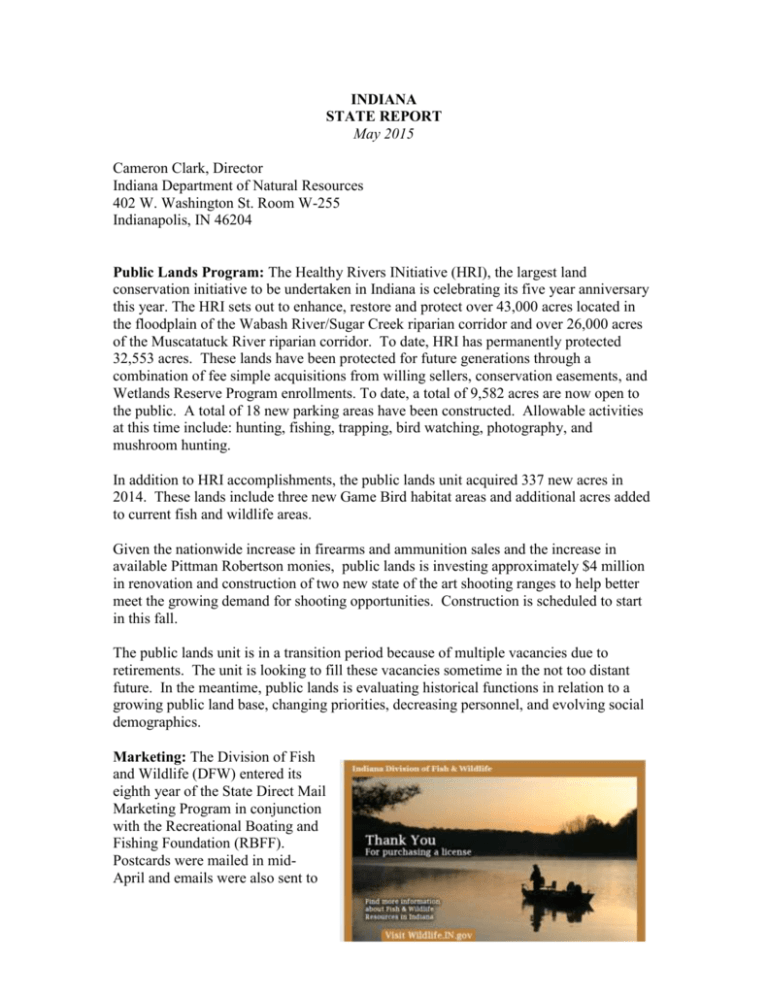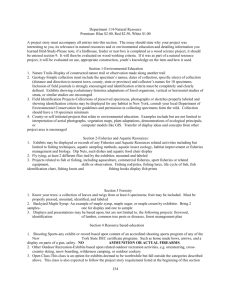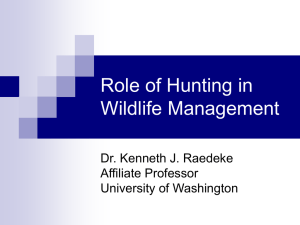Indiana
advertisement

INDIANA STATE REPORT May 2015 Cameron Clark, Director Indiana Department of Natural Resources 402 W. Washington St. Room W-255 Indianapolis, IN 46204 Public Lands Program: The Healthy Rivers INitiative (HRI), the largest land conservation initiative to be undertaken in Indiana is celebrating its five year anniversary this year. The HRI sets out to enhance, restore and protect over 43,000 acres located in the floodplain of the Wabash River/Sugar Creek riparian corridor and over 26,000 acres of the Muscatatuck River riparian corridor. To date, HRI has permanently protected 32,553 acres. These lands have been protected for future generations through a combination of fee simple acquisitions from willing sellers, conservation easements, and Wetlands Reserve Program enrollments. To date, a total of 9,582 acres are now open to the public. A total of 18 new parking areas have been constructed. Allowable activities at this time include: hunting, fishing, trapping, bird watching, photography, and mushroom hunting. In addition to HRI accomplishments, the public lands unit acquired 337 new acres in 2014. These lands include three new Game Bird habitat areas and additional acres added to current fish and wildlife areas. Given the nationwide increase in firearms and ammunition sales and the increase in available Pittman Robertson monies, public lands is investing approximately $4 million in renovation and construction of two new state of the art shooting ranges to help better meet the growing demand for shooting opportunities. Construction is scheduled to start in this fall. The public lands unit is in a transition period because of multiple vacancies due to retirements. The unit is looking to fill these vacancies sometime in the not too distant future. In the meantime, public lands is evaluating historical functions in relation to a growing public land base, changing priorities, decreasing personnel, and evolving social demographics. Marketing: The Division of Fish and Wildlife (DFW) entered its eighth year of the State Direct Mail Marketing Program in conjunction with the Recreational Boating and Fishing Foundation (RBFF). Postcards were mailed in midApril and emails were also sent to select anglers. The DFW also attended RBFF’s state marketing meeting in Dallas, TX in which 48 states attended and discussed marketing strategies. The Indiana Division of Fish and Wildlife was selected to speak about our Hunt, Fish, Eat and CookIN Gone Wild programs at this meeting. Our email marketing campaign was also highlighted as one of the states that is presenting emails in a user-friendly way and used as an example of how to do email marketing. A strategic email marketing program was also developed that includes “thank you” emails for license purchases, reminders on upcoming seasons, and results of reserved hunt draws. A printed hunting/trapping and fishing guide is available through a contract with J.F. Griffin, information and regulations are shared in these guides annually. We have also started a DNR–wide YouTube channel. This channel features DFW programs, how to videos, and educational/informational videos for the public. A monthly enewsletter, Wild Bulletin, is also sent out on a monthly basis to over 300,000 subscribers and offers DNR news, events, and license purchasing information. Private Lands Program: Private lands biologists implemented wildlife management plans with 523 landowners, impacting 4,687.82 acres, including the development of 2,342.3 acres of idle nesting cover, 707.5 acres of fescue eradication, and 846.7 acres of CRP mid-contract management. Biologists also addressed 1,765 nuisance wildlife complaints, including 433 deer and 301 goose complaints. To date 26,488 acres have been enrolled in CP38 in Indiana. Wildlife Science Program: During the past year, research biologists within the Wildlife Diversity Unit and Wildlife Research Unit were merged together to form the Wildlife Science Unit. Biologists within this unit serve as our wildlife species experts and are the research and monitoring arm of the wildlife section. Personnel supervise and conduct numerous surveys to monitor the status, distribution and relative abundance of fish and wildlife populations throughout the state which include surveys such as, basic statistics from statewide mobile acoustic bat surveys, Franklin ground squirrels and swamp rabbit surveys, various migratory bird surveys to assess the migratory bird populations. In addition, a number of external multi-year grant projects are being funded including: - A deer dispersal and genetic study in southern Indiana. This is a follow-up to the fawn mortality and dispersal study in the same area. The purpose of the fawn project is to help us better understand the roles that fawn survival and dispersal play in the population dynamics of urban/suburban versus rural deer populations. The purpose of the deer dispersal and genetic study is to help us understand herd dynamics of deer in both the urban and non-urban areas and if there are any movements and interactions of deer between urban and non-urban populations. - Development of an outreach campaign to help protect five federally listed mussels in the Tippecanoe River. - Evaluating awareness and attitudes of humans toward eastern hellbenders in the Blue River watershed. - Repatriation of eastern hellbenders via translocation and head-starting and assessing juvenile survival in eastern hellbenders. - Ranavirus surveillance in Box turtles and aquatic amphibians. - Local and landscape habitat association, population ecology, and the future recovery of crawfish frogs (Rana areolate) in Indiana. - Winter censuses of hibernating bats in southern Indiana caves. - Analysis of microclimate conditions at winter roost sites in bat hibernacula in Indiana. - Impacts of White-Nose Syndrome on a bat community near the Indianapolis Airport. - Managing genetic isolation due to habitat fragmentation: A model-based tool for using assisted migration as an aid to recovery of Allegheny woodrats. - The Southern Wings program was developed in 2009 by the Association of Fish and Wildlife Agencies to provide an efficient means for states to support conservation projects in tropical areas that benefit their species of greatest conservation concern. Wildlife science unit biologists are also heavily involved in disease monitoring. Whitenose Syndrome, Bovine tuberculosis, Epizootic Hemorrhagic Disease and Chronic Wasting Disease surveillance programs continued this year. Recruitment and Retention: The Indiana Division of Fish and Wildlife along with its many volunteers and partners conducted a variety of fishing, hunting and shooting recruitment/retention activities across the state. These activities range from free fishing weekend events, family learn to fish programs to mentored hunts for both youth and novice hunters to introductory shooting activities for families. We facilitated seven crew captain workshops through our Go FishIN program, three master naturalist classes, two classes at Becoming an Outdoor Woman fished with 2,800 kids at the state fair fishing pond, had 1,300 people fishing at the Hoosier Outdoor Experience, taught 600 kids how to cast at the Outdoor Challenge and had 2,700 people at our free fishing day events. We also took a fishing trip down the White River and invited the public to join us for the White River Festival, this including fishing at easily accessible locations and catching a fish at each one throughout the day, anglers and interested parties could follow our journey on facebook and twitter. DFW staff facilitated over 40 hunting events with over 1,200 participants throughout the year 1,500 presentations on fish and wildlife topics, had 12,000 participants at our annual Hoosier Outdoor Experience for fish and wildlife events, and had 2,000 participants in our annual wild game cookout at the Indiana State Fair. We have continued our CookIN Gone Wild: Field-to-Table series on YouTube to allow people to see what it takes to go from the field to the table, including hunting, fishing, cleaning, and cooking. Twenty-six videos have been produced with over 63,900 views. This video series is meant to get people interested in hunting and fishing activities and give them the tools to venture out on their own. We have also developed videos on deer hunting tips for beginners and how to process your wild turkey or Canada goose to help out new and existing hunters. We started an apprentice license program, allowing individuals to try hunting without having to take a hunter education course, in 2009, a 43% increase in apprentice license sales have been observed from 2009-2014. Our overall license numbers have decreased since 2012, however our revenue has increased. This is due to the new deer bundle license that was first offered in 2012. This license allows hunter to harvest three deer throughout multiple seasons. All of our recruitment and retention efforts are designed to take participants from a basic knowledge of fishing/hunting/shooting to the ability to participate in these activities on their own. Lake and River Enhancement (LARE) Program: In fiscal year 2014-2015, the Lake and River Enhancement (LARE) Program provided over $1.75 million in grants to sponsors in numerous Indiana counties. While many grants dealt with management and control of aquatic invasive vegetation, others served the dual purpose of addressing sediment and nutrient input into lakes or rivers as well as measures to improve aquatic habitat. LARE partnered with other local, county, state, and federal agencies to address these issues while leveraging funds from sources other than state tax revenue. Local citizens get involved as participants with project sponsoring entities responsible for 20% to 50% of the cost in cash or inkind support. The 70 projects funded included control of invasive aquatic vegetation, logjam removal, sediment removal, and various biological and engineering measures to reduce the input of nutrients and sediment in lakes or rivers. In 2014-2015, several of the projects specifically targeted means to improve aquatic habitat in addition to addressing stream bank stability, such as the one pictured below in Marshall County. Several large sediment removal projects to improve public recreational access to Indiana lakes were started in this time period also. The restored shoreline of Lake Galbraith included plantings of native species, installation of coir logs with rock toe reinforcement, and was completed in 2014. (Photo courtesy of Cardno JFNew, the contractor who completed project with LARE funding. Asian Carp Update: Eagle Marsh in Ft. Wayne, IN lies on the continental divide between the Mississippi River basin and the Great Lakes basin. Behind the Chicago Area Waterway System, the Eagle Marsh location was deemed the second highest potential pathway for Asian carp to reach the Great Lakes. A temporary fence was installed across Eagle Marsh in 2010 to prevent the transfer of adult Asian carp. Planning was underway soon thereafter to develop a permanent solution to prevent all AIS transfer at the location. The solution will involve the reconstruction of the failing berm that is adjacent to the Graham-McCulloch Ditch which flows through the property. Site preparation for the project began in the fall of 2014 and construction of the new berm will begin in the late spring of 2015 with completion expected in the fall of 2015. The construction of the berm will disturb approximately 16 acres of wetlands. As a result 38 acres of lowland property which is mostly agricultural is being purchased nearby for wetland restoration efforts to mitigate for the wetland loss on Eagle Marsh. Construction of the mitigation area is expected to be completed in the fall of 2015. The primary partners in the berm reconstruction and mitigation projects include Indiana DNR, NRCS, and Little River Wetlands Project which is a local non-profit land trust and co-owner of Eagle Marsh. Funding is provided by NRCS and the Great Lakes Restoration Initiative. Two Asian carp research projects were completed late in 2014 through contracts with Purdue University using Great Lakes Restoration Initiative funding. The first was a four year study to understand the movement, reproduction, and habitat use of Asian carp in the upper Wabash River. The second project evaluated the susceptibility of Asian carp to a variety of pathogens. Go FishIN in the City: Go FishIN in the City is Indiana DNR’s urban fishing program that was enacted in 2013. This program provides great shore fishing opportunities for Hoosiers that live in heavily populated urban areas. With the help of local partners, the Indiana Department of Natural Resources will intensively stock catchable size channel catfish and rainbow trout throughout the year in small city lakes. The selected lakes are located in local city parks that are family friendly and well maintained. Several free fishing day and family learn to fish workshops have taken place at these lakes throughout the state to promote fishing and family outdoor activities close to home. http://www.in.gov/dnr/fishwild/7508.htm Public Access Program: In 2014, DFW rehabbed six Public Access Sites (PAS) in Indiana. These include Goose Lake PAS in Whitely County, Cedar Lake PAS in Lake County, Jimmerson Lake PAS in Steuben County, Elnora PAS in Daviess County, Driftwood Public Fishing Area in Bartholomew County, and Bluegrass PAS in Warrick County. These public access sites were in need of repairs due to their old age. A new canoe site was completed in northern Indiana named Aubbeenaubee PAS in Fulton County. This will be a new site for the public to access the Tippecanoe River (photo below). A new boat ramp for our Healthy Rivers Initiative in Vigo County named Riverview PAS was also completed. This new site will allow boaters to enjoy the Wabash River in that area. For 2015, we have six public access projects planned for Northern Indiana. Canoe access sites include: Ligonier PAS on the Elkhart River in Noble County, Riverside Park PAS on the Eel River in Cass County, Maumee Dam PAS on the Maumee River in Allen County and St. Joe College on the Iroquois River in Jasper County. Boat launch sites include: Pittsburgh on the Wabash River in Carroll County and Pike Lake PAS on Pike Lake in Kosciusko County. In southern Indiana we have three boat ramp rehabilitations scheduled. These include Winslow PAS in Pike County, Medora PAS in Jackson County, and Worthington PAS in Greene County. It is planned to have a new entrance road and parking lot completed at our Three Rivers Public Fishing Area in Morgan County in 2015.







